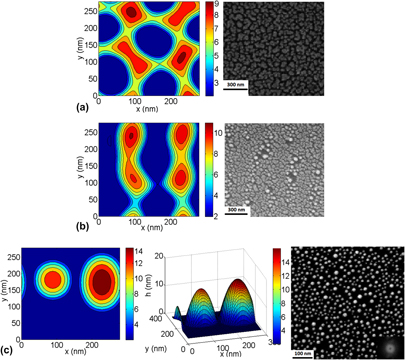Crossref Citations
This article has been cited by the following publications. This list is generated based on data provided by
Crossref.
Yadavali, S
Sachan, R
Dyck, O
and
Kalyanaraman, R
2014.
DC electric field induced phase array self-assembly of Au nanoparticles.
Nanotechnology,
Vol. 25,
Issue. 46,
p.
465301.
Vella, Jarrett H.
Goldsmith, John
Limberopoulos, Nicholaos I.
Derov, John S.
and
Drehman, Alvin J.
2014.
High throughput, large scale, broadband, plasmonic nanostructure fabrication for optical sensors.
p.
29.
Yadavali, S.
and
Kalyanaraman, R.
2014.
Nanomaterials synthesis by a novel phenomenon: The nanoscale Rayleigh-Taylor instability.
AIP Advances,
Vol. 4,
Issue. 4,
Ooms, Matthew D.
Jeyaram, Yogesh
and
Sinton, David
2015.
Disposable Plasmonics: Rapid and Inexpensive Large Area Patterning of Plasmonic Structures with CO2 Laser Annealing.
Langmuir,
Vol. 31,
Issue. 18,
p.
5252.
Kondic, L.
Dong, N.
Wu, Y.
Fowlkes, J.D.
and
Rack, P.D.
2015.
Instabilities of nanoscale patterned metal films.
The European Physical Journal Special Topics,
Vol. 224,
Issue. 2,
p.
369.
Sachan, Ritesh
Malasi, Abhinav
Yadavali, Sagar
Griffey, Blake
Dunlap, John
Duscher, Gerd
and
Kalyanaraman, Ramki
2015.
Laser-Induced Self-Assembled Nanostructures on Electron-Transparent Substrates.
Particle & Particle Systems Characterization,
Vol. 32,
Issue. 4,
p.
476.
Yadavali, S
Sandireddy, V P
and
Kalyanaraman, R
2016.
Transformation of irregular shaped silver nanostructures into nanoparticles by under water pulsed laser melting.
Nanotechnology,
Vol. 27,
Issue. 19,
p.
195602.
Stolzenburg, H.
Peretzki, P.
Wang, N.
Seibt, M.
and
Ihlemann, J.
2016.
Implantation of plasmonic nanoparticles in SiO2 by pulsed laser irradiation of gold films on SiO -coated fused silica and subsequent thermal annealing.
Applied Surface Science,
Vol. 374,
Issue. ,
p.
138.
Peláez, R.J.
Rodríguez, C.E.
Afonso, C.N.
and
Škereň, M.
2016.
Tuning the plasmonic response of bimetallic films by laser irradiation.
Surface and Coatings Technology,
Vol. 295,
Issue. ,
p.
54.
Sánchez-Aké, C.
Canales-Ramos, A.
García-Fernández, T.
and
Villagrán-Muniz, M.
2017.
Nanosecond pulsed laser nanostructuring of Au thin films: Comparison between irradiation at low and atmospheric pressure.
Applied Surface Science,
Vol. 403,
Issue. ,
p.
448.
Donovan, Brian F.
Tomko, John A.
Giri, Ashutosh
Olson, David H.
Braun, Jeffrey L.
Gaskins, John T.
and
Hopkins, Patrick E.
2017.
Localized thin film damage sourced and monitored via pump-probe modulated thermoreflectance.
Review of Scientific Instruments,
Vol. 88,
Issue. 5,
Bhaumik, Anagh
and
Narayan, Jagdish
2018.
Synthesis and Characterization of Quenched and Crystalline Phases: Q-Carbon, Q-BN, Diamond and Phase-Pure c-BN.
JOM,
Vol. 70,
Issue. 4,
p.
456.
Censabella, Maria
Ruffino, Francesco
Zimbone, Massimo
Bruno, Elena
and
Grimaldi, Maria G.
2018.
Self‐Organization Based Fabrication of Bimetallic PtPd Nanoparticles on Transparent Conductive Oxide Substrates.
physica status solidi (a),
Vol. 215,
Issue. 3,
Hou, Huichao
Ji, Zhengjia
Xie, Zhong
and
Jin, Hongyun
2018.
Spheroidizing mechanisms and simulation of spherical silica in Oxygen-Acetylene flame.
Advanced Powder Technology,
Vol. 29,
Issue. 3,
p.
789.
Yoo, Jae-Hyuck
Nguyen, Hoang T.
Ray, Nathan J.
Johnson, Michael A.
Steele, William A.
Chesser, John M.
Baxamusa, Salmaan H.
Elhadj, Selim
McKeown, Joseph T.
Matthews, Manyalibo J.
and
Feigenbaum, Eyal
2019.
Scalable Light-Printing of Substrate-Engraved Free-Form Metasurfaces.
ACS Applied Materials & Interfaces,
Vol. 11,
Issue. 25,
p.
22684.
Ray, Nathan J.
Yoo, Jae H.
Nguyen, Hoang T.
Johnson, Michael A.
Baxamusa, Salmaan H.
Elhadj, Selim.
McKeown, Joseph T.
Matthews, Manyalibo J.
and
Feigenbaum, Eyal.
2019.
Enhanced Control of Size and Shape of Gold Nanoparticles Produced by a Simple and Scalable Thermal Process.
p.
FTh1C.4.
Ray, Nathan J.
Yoo, Jae H.
McKeown, Joseph T.
Elhadj, Selim
Baxamusa, Salmaan H.
Johnson, Michael A.
Nguyen, Hoang T.
Steele, William A.
Chesser, John M.
Matthews, Manyalibo J.
and
Feigenbaum, Eyal
2019.
Enhanced Tunability of Gold Nanoparticle Size, Spacing, and Shape for Large-Scale Plasmonic Arrays.
ACS Applied Nano Materials,
Vol. 2,
Issue. 7,
p.
4395.
Garfinkel, David A.
Pakeltis, Grace
Tang, Nan
Ivanov, Ilia N.
Fowlkes, Jason D.
Gilbert, Dustin A.
and
Rack, Philip D.
2020.
Optical and Magnetic Properties of Ag–Ni Bimetallic Nanoparticles Assembled via Pulsed Laser-Induced Dewetting.
ACS Omega,
Vol. 5,
Issue. 30,
p.
19285.
Owusu-Ansah, Ebenezer
Birss, Viola I.
and
Shi, Yujun
2020.
Mechanisms of Pulsed Laser-Induced Dewetting of Thin Platinum Films on Tantalum Substrates—A Quantitative Study.
The Journal of Physical Chemistry C,
Vol. 124,
Issue. 42,
p.
23387.
Fulton, Alison Joy
Ozhukil Kollath, Vinayaraj
Karan, Kunal
and
Shi, Yujun
2020.
Gold nanoparticle assembly on porous silicon by pulsed laser induced dewetting.
Nanoscale Advances,
Vol. 2,
Issue. 2,
p.
896.



